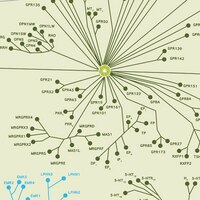Galanin receptor-1 knockout mice exhibit spontaneous epilepsy, abnormal EEGs and altered inhibition in the hippocampus.
McColl, Craig D, et al.
Neuropharmacology, 50: 209-18 (2006)
2006
概要を表示する
Galanin is a widely-distributed neuropeptide that acts as an endogenous anticonvulsant. We have recently generated a galanin receptor type 1 knockout mouse (Galr1(-/-)) that develops spontaneous seizures. Our aim here was to characterize the seizures by making electroencephalogram (EEG) recordings from this animal, and also to elucidate the cellular basis of its epileptic phenotype by studying the neurophysiology of CA1 pyramidal neurons in acute hippocampal slices. EEGs showed that major seizures had a partial onset with secondary generalization, and that paroxysms of spike-and-slow waves occurred and were associated with hypoactivity. The interictal EEG was also abnormal, with a marked excess of spike-and-slow waves. Slice experiments showed that resting potential, input resistance, intrinsic excitability, paired-pulse facilitation of excitatory and inhibitory postsynaptic currents (EPSCs and IPSCs), stimulus--response plots for EPSCs, and several properties of spontaneous miniature EPSCs and IPSCs were all unchanged in the mutant mouse compared with wildtype. However, the frequency of miniature IPSCs was significantly reduced in the mutants. These results suggest that impaired synaptic inhibition in the hippocampus may contribute to the local onset of seizures in the Galr1(-/-) mouse. | 16243364
 |
Galanin and its receptors: introduction to the Third International Symposium, San Diego, California, USA, 21-22 October 2004.
Hökfelt, Tomas
Neuropeptides, 39: 125-42 (2005)
2005
概要を表示する
The Third Galanin Symposium presented many different and exciting results on galanin research reflecting a major progress since the previous symposium in 1998. A major impression was the many possible relationships of galaninergic mechanisms to important brain functions such as development, cognition and ageing as well as many aspects related to a wide spectrum of diseases, including Alzheimer's disease, anxiety/depression, addiction, obesity, pain and tumour growth. These studies were based on an extensive armament of methodologies including various strains of transgenic mice. Unfortunately, the pharmaceutical industry had only a minor participation. Nevertheless, exciting developments in the generation of agonists and antagonists are emerging, providing hope that we at the next symposium will be able to validitate many of the challenging hypotheses concerning galanin and disease with the help of pharmacological tools. | 15908000
 |
Patterns of seizures, hippocampal injury and neurogenesis in three models of status epilepticus in galanin receptor type 1 (GalR1) knockout mice.
Mazarati, A, et al.
Neuroscience, 128: 431-41 (2004)
2004
概要を表示する
The neuropeptide galanin exhibits anticonvulsant effects in experimental epilepsy. Two galanin receptor subtypes, GalR1 and GalR2, are present in the brain. We examined the role of GalR1 in seizures by studying the susceptibility of GalR1 knockout (KO) mice to status epilepticus (SE) and accompanying neuronal injury. SE was induced in GalR1 KO and wild type (WT) mice by Li-pilocarpine, 60 min electrical perforant path stimulation (PPS), or systemic kainic acid (KA). Seizures were analyzed using Harmonie software. Cell injury was examined by FluoroJade B- and terminal deoxynucleotidyl transferase-mediated uridine triphosphate nick end labeling; neurogenesis was studied using bromodeoxyuridine labeling. Compared with WT littermates, GalR1 KO showed more severe seizures, more profound injury to the CA1 pyramidal cell layer, as well as injury to hilar interneurons and dentate granule cells upon Li-pilocarpine administration. PPS led to more severe seizures in KO, as compared with WT mice. No difference in the extent of neuronal degeneration was observed between the mice of two genotypes in CA1 pyramidal cell layer; however, in contrast to WT, GalR1 KO developed mild injury to hilar interneurons on the side of PPS. KA-induced seizures did not differ between GalR1 KO and WT animals, and led to no injury to the hippocampus in either of experimental group. No differences were found between KO and WT mice in both basal and seizure-induced neuronal progenitor proliferation in all seizure types. Li-pilocarpine led to more extensive glia proliferation in GalR1 KO than in WT, and in both mouse types in two other SE models. In conclusion, GalR1 mediate galanin protection from seizures and seizure-induced hippocampal injury in Li-pilocarpine and PPS models of limbic SE, but not under conditions of KA-induced seizures. The results justify the development and use of GalR1 agonists in the treatment of certain forms of epilepsy. | 15350653
 |












